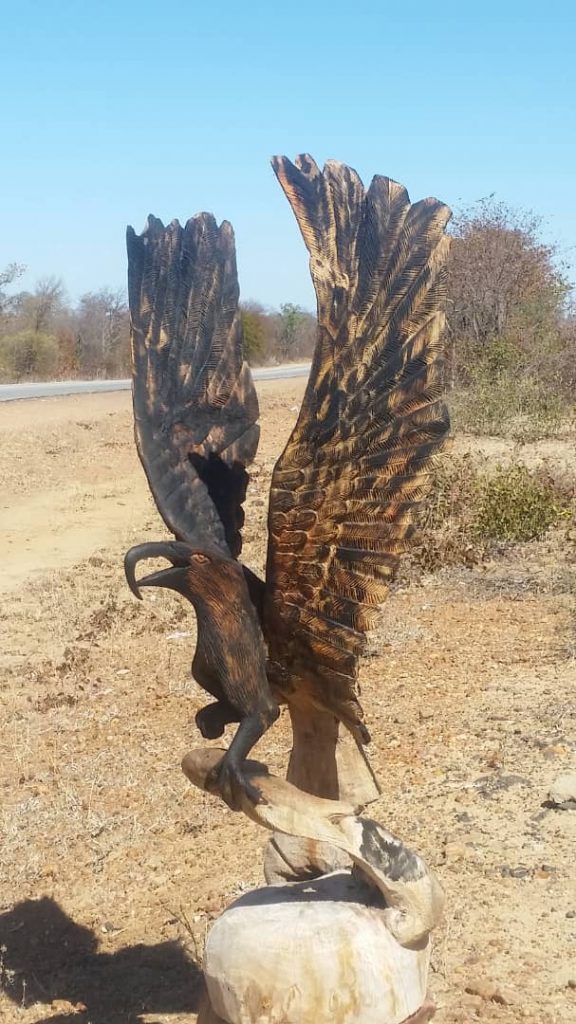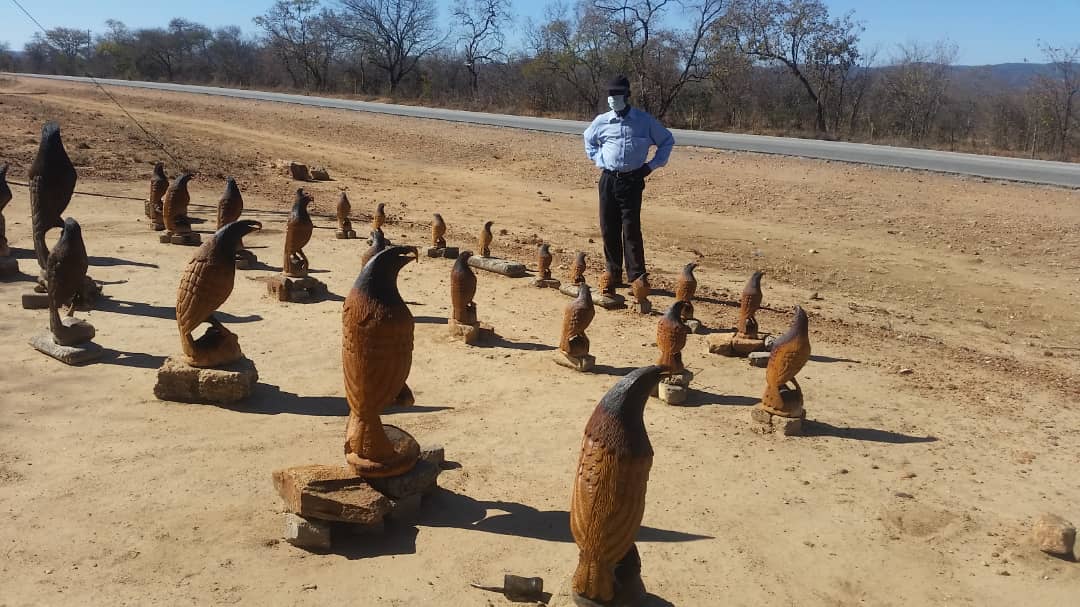By Nimrod Ushe
Wood carvings galleries along the Masvingo-Beit Bridge Highway are among the places where wooden art is exhibited in great sizes and styles. Most of the artists use their creative genius and imagination to craft some of the best Zimbabwean curios.
This week, the Spiked Online Media team toured Mubatiwemaoko and Tokwe Craft Centre galleries which are at 40km from the city centre in the Masvingo Rural Council along Beit-Bridge -Masvingo main road.
Forget about the well-structured institutions. There are no formalised buildings as one might think of. The rooms are made from improvised materials gathered from the highway and the local environment such as the pole and mud (dhaka) and thatched materials. The other gallery is an abandoned Postal and Telecommunications Transmission House.
Is wood carvings art for art’s sake? The answer might be no because most of the decorative objects can be useful in people’s lives. Wood artists make a laden of daily usable implements such as coffee tables (used at eating houses), stuff (helps the elderly as an extra leg), flower containers (for decorating items), and wooden bowls ( for serving foodstuffs).

On a different note, the art of carving wood to decorative objects could be undertaken for various socio-religious reasons. Items such as wooden rods could be of sacred beliefs. Just like in the Biblical times when Moses used his staff to perform miracles. In African Indigenous Churches wood carved rods can be used for similar functions. Notably, the Mapumhangangozi wooden rod is believed to have supernatural powers by the Zion Christian Church members.
Wooden carvings help to preserve our social and historical identity. For example, totemic birds and animals like buffalo, crocodile, hippos, and warthogs can be successfully carved as an emblem of a tribe, clan or even a family. Misheck Ncube points out that “In most cases, people purchase some of my curios as totemic symbols and probably furnish their homes and it will serve as a reminder of their totemic beliefs. For example, one can purchase the Fish Eagle (Hungwe ) “.
Totems in Zimbabwe and most African societies can help as a form of identity and they describe the people’s uniqueness, social, economic, or historical background as noted by Mavondo and Chikati (2017).
Although, the art of carving wood can be deemed as a traditional source of livelihood it can help to market our Zimbabwean culture even beyond our borders.
“Culturally, the Hungwe bird is a national trademark for the Zimbabweans. So foreigners from as far as the United Kingdom and the United States of America appreciate our culture through wood carvings and in most cases they purchase our products as souvenirs, ” said Ncube.
Some say “Artists should not be judged by ordinary standards”. Indeed, woodcarvers ought not to be adjudicated by the dirt work suits, as they can turn some of the dry woods from seasoned African trees such as Mugwiti, Mutsviru, Mutovhoti, Mukwa, Mukamba (Pod Mohagamy ), and Fresh Teak into aesthetic objects.
They practice sustainable ways of sourcing their raw materials. Most of the wood is easily obtainable from the flood plains of the Tokwe Mukosi river. And some of the wood for the art is procured from close by resettled farmers after clearing their farms.
How did woodcarvers get started or who recruits them? One might think of having the best 5 Ordinary levels, Diploma, or even a Ph.D. That is totally not correct. Misheck Ncube started as an art dealer and he realised that he could do it on his own and later pursued his desires and the rest is now history.
Charles Mazviwa began by merely looking at other artists doing their job and his passion developed until he was taught by his friends. Whilst Joseph Matsutso was a tools man and with time he was taught the art and he became one of the greatest artists.
Wood carving art is more than just a profession – it is a way of life. As such, people like Charles Mazviwa claim that he could receive divine oracles such as dreams and visions from the gods. Apart from that, he mastered the skill visual and proportions of anything into carving visiting many places, and watching game animal sites. Moreover, the art of carving wood is now in the blood vessels of the most artists visited by the Spiked Online Media team. Just like Misheck Ncube, some of the unfinished artwork could be finished off on his back yard.
Despite Zimbabwe’s current economic woes, wood artists keep their heads high hoping that the future might be bright. Ncube said, “The is drought and COVID-19 in the country.” But he noted that “they should continue to soldier on. One day life will be better and there is life after the Covid-19 era.” Meanwhile, there was a Masvingo COVID-19 Fund for all artists of mankind and applications were done online using the following [email protected].
However, it’s deadline lapsed yesterday and the Spiked Online Media team is hoping that it will be extended in order to assist various artists across the province. The National Arts Council worker could not provide much of the details about its extension because the deadline was yesterday and today happens to be a weekend so their offices are closed.
“The deadline was 31 July and today being a weekend I don’t have information. Maybe keep in touch,” said Mrs. Mudefi, the National Arts Council of Masvingo Provincial Arts manager.
Mupisa (2017) opines that art is a source of income. Zimbabwean art benefits individuals, communities, and even the nation financially. Indeed wood craftwork played a pivotal role as a revenue generator to most of the youth along the snaking Beit-Bridge highway. On a good day, one can rack as much as $20 or $50 Usd for a piece.
Perhaps one of the mind gobbling questions for most of the readers is how these artists are copying with the COVID – 19 crisis. Misheck Ncube might have to find the solution as he maintains the social distance by doing it alone. This might have been a preventive measure against COVID- 19 because the disease is usually spread through human contact. And sometimes if he heard that the pandemic is rising high he shelved some of his artwork in his homestead.
Apart from that, with most of the overseas and South African tourists in hibernation, how do these artists survive without foreign-based customers? Some of the woodcarvers have realised that local customers can help them during this quagmire. Misheck Ncube said, “I think we have to rely on local customers since can also afford to buy their products meaning especially the bourgeois (varungu-vatema).”
However, some people cannot afford to buy their products and wood artists were crying out that the “new” customers, the heavy-duty truck drivers don’t want to spend much on their products. Joseph Matsutso said, “Most of the truck drivers are stingy as compared to light traveled motorists during the normal times.”
In assessing the situation one might see that the truck drivers are currently working on a tight budget and tight situation caused by the COVUD -19 pandemic. So given that situation they might not have an extra cent to spend on wood carving galleries.
Most of the challenges noted by the Spiked Online Media crew is that wood art carvers do not have proper tools and even galleries to house their stock. Misheck Ncube appealed to the corporate world to donate some professionally made tools because most of the tools they used are homemade.
He added that it is also challenging to showcase some of their products especially during the rainy season because he won’t have shades or a proper art gallery. Woodcarvers advised house cleaners to dust off their wooden carvings regularly especially in the month of August where the mighty wind raises a lot of dust in their homes. More so, they urged home cleaners to apply vanishing oil and even floor polish cobra (Chitaitai) to some of their wood carved products in order to keep them shining and to last for posterity.






